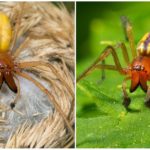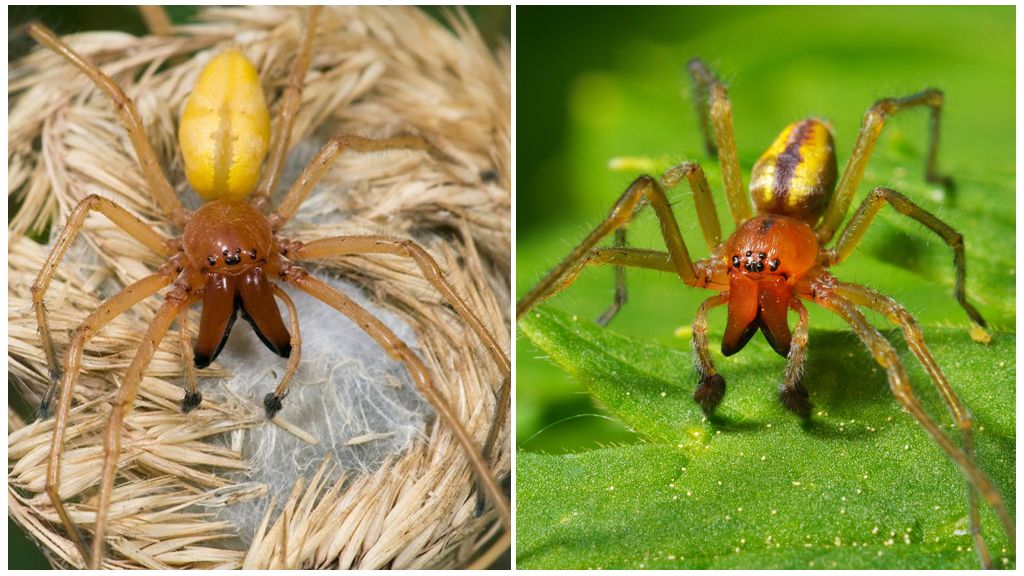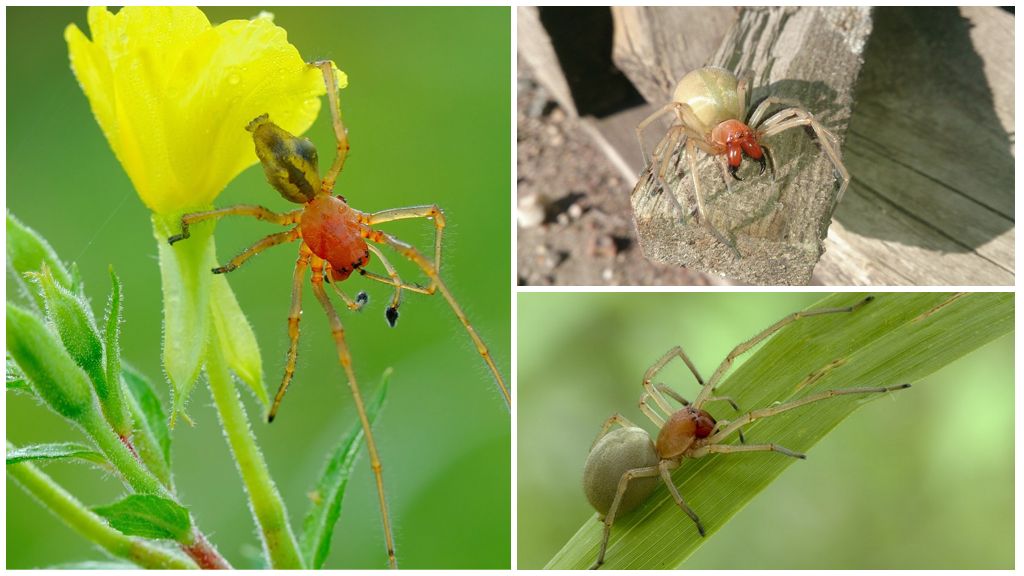Description and photo of the spider Sak (Heiracantium)
Content
- Yellow Spider Sac
Yellow Sac Spider or Heirakantium is a typical representative of predators. It feeds on small insects - aphids, mites, caterpillars, moths. The brightest species live in tropical countries with a warm, humid climate. In Russia, the former CIS countries are found in the summer. He lives in the forest, in the fields, forest edges, gardens, kitchen gardens, city parks. Climate change and hot long summer contributed to the resettlement of the yellow spider.
Photos and appearance description
Predatory spider SAC small size. The body of an adult individual is only 10 mm. In the span of the limbs - 25 mm. Females are several times larger than males. The body consists of the abdomen, cephalothorax. Covered with a thick shell. 4 pairs of legs, front limbs help to grab the victim, to keep in the process of feeding.
The abdomen is bright yellow. A little darker paws. The head is massive, red-brown in color. Powerful jaws, pointed, rounded at the end, are striking. With this piercing weapon, the predator breaks the shell, the chitinous cover of the victim, and then injects poison.
On a note!
On the head there are 8 eyes that come together in groups, but the vision is poor. The organs of smell, the sense of touch, located on the limbs, help orient oneself in the environment. Spider golden Sak senses the approach of the victim, the enemy by the vibrations of air, cobwebs, smell.
The male has a tan cover, not as bright as the females. The size of the spider with its limbs barely reaches 15 mm. The main mission is female fertilization. Then the arthropod is killed.
A photo of the Saka Spider is located below. You can consider the structural features of the body, color, powerful jaws of a predator.
What does the web look like?
The spider does not spread the web of hunters in the form of a web typical of many representatives of arachnids. Sak sets up a sack into which the victims fall from the dense threads-cobwebs. Such a cocoon weaves after fertilization for laying eggs. Often the web blocks the entrance to the shelter. The predator is engaged in "needlework" at night, in the afternoon it sits quietly in the chosen place.
Where dwells
The genus Heiracantium includes 194 species. Members of the family inhabit almost all the continents. The brightest species live in tropical countries. The warm climate, hot, long summer contributed to the settlement of the predator. In recent years, the yellow spider sack is often found on the territory of Russia. He lives in the grass, forest floor, mink, under stones, as well as in gardens, in gardens, can get into the house.
Breeding
The life span of the female is 1 year. The mating season begins in mid-summer, by the end the female lays eggs. For masonry, it initially forms a cocoon bag from its own web. At one time, the spider lays up to 600 eggs. Cubs develop a few weeks. The female keeps a cocoon near herself, provides a safe formation.
After the birth of the young, the Saka Spider cubs live with their mother for a long time. Initially, it provides them with food, learns to hunt. For the entire period of maturation, spiders pass up to 7 molts, each time increasing in size.
Interesting!
At the last stage, the genitals are formed, the body acquires a characteristic color. Adults heirakantiuma eat up the mother, start reproduction themselves.
Food, spider lifestyle
Yellow golden Sak is nocturnal, hiding in secluded places during the day. Food for him are caterpillars, aphid, moth. The spider waits for them in the shelter, and then immediately jumps at a leap. Powerful jaws spider gnaws chitinous cover, injects poison.
Toxic substance affects the nervous system, paralyzing the muscles of the insect. In the wound, the predator injects saliva, which dilutes the insides of the prey to the condition of the broth, leaving the prey for several minutes. After some time, the spider returns, sucks the entrails, leaving only the chitinous cover from the insect. The same fate awaits an insect entangled in the web.
Poisonous or not
Yellow spider heirakantium possesses poisonous glands, injects a toxic substance into the victim's wound. For a person, the dose of poison is extremely small, so there is no danger to life. A predator attacks people rarely when they impinge on his own life. However, the probability of being bitten increases if the spider gets under the clothes or is accidentally crushed with a bare foot, hand.
After the bite, unpleasant symptoms appear:
- pain;
- burning;
- redness;
- edema;
- blisters;
- suppuration.
Day place bite hurts, burns. The next day, itching is replaced by painful sensations.
In people prone to allergies, with a weakened immune system, young children may develop common symptoms of intoxication.
- headache;
- weakness;
- difficulty breathing;
- vomiting;
- abdominal pain;
- cardiopalmus;
- high blood pressure;
- change in body temperature.
Local symptoms go away on their own after a few days, in the presence of signs of intoxication should consult a specialist. The probability of severe allergies is enhanced if the spider has bitten repeatedly or there have been several of them. There were no deaths after the bite of Saka.
On a note!
When a heiracanthium spider is found in the house, one should not make any sudden movements, try to crush it. Arthropod well jumps, instantly puts a bite with powerful jaws. Initially, the predator should be covered with a can, a bucket, any container that came handy. Gently cover with a sheet of paper, take out the street, shake off the container. If the decision is made to kill a predator - sprinkle any insecticide on it.
Benefit
The poisonous spider is recognized as an active killer of pests of agricultural crops. During the season, one small female eats more than 2 thousand caterpillars, an adult moth, aphids. Especially nobody launches yellow Sakas into the territory, but if they appear, they do not rush to use insecticides. Human harm from spiders is small, people suffer through negligence. But the benefits to the environment are huge. Predators regulate the number of harmful insects devouring plants, crops, trees.








